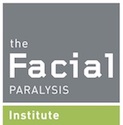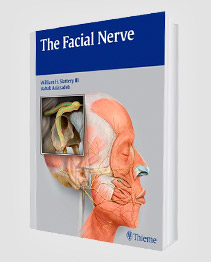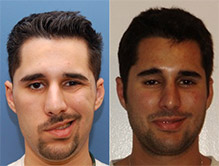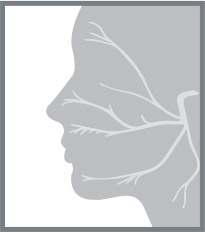Immediate diagnosis and treatment of facial nerve weakness and hearing loss is crucial. By meeting with a doctor, a patient can undergo an evaluation to find out if these symptoms are related to Bell’s palsy and treat them accordingly.
What Is the Link Between Bell’s Palsy and Hearing Loss?
Bell’s palsy affects the seventh cranial nerve. At onset, the condition can cause facial paralysis, along with a fever, stiff neck, and other physical symptoms. In rare instances, Bell’s palsy can also cause hearing loss.
Hearing loss due to nerve weakness may be related to Bell’s palsy. Patients dealing with Bell’s palsy may experience severe pain in the ear on the affected side of their face and recurrent facial nerve weakness. These symptoms can occur without notice, and they may disappear on their own shortly after onset. But, if the symptoms linger for several weeks or months after onset, a patient should pursue medical treatment. At this point, the patient may require various tests to determine if their symptoms are related to Bell’s palsy or another medical condition.
How Is Bell’s Palsy Diagnosed?
There is no single test used to diagnose Bell’s palsy and hearing loss. Instead, a doctor may perform a hearing test to determine if a patient is dealing with inner ear issues or has suffered hearing damage. The doctor may also perform other assessments, including:
- Ear, Nose, and Throat (ENT) Evaluation: Determines if a patient is dealing with an inner ear infection or head or neck tumor. An ENT test may be used if a patient is dealing with dizziness in combination with hearing loss and other Bell’s palsy symptoms.
- Neurologic Assessment: Tests a patient’s reflexes, movement, and level of consciousness.
- Vestibular Exam: Provides insights into a patient’s nerve balance.
- Tearing Test: Allows a doctor to analyze a patient’s tearing function.
- Imaging Scans: Delivers images that show if a patient is dealing with a tumor, skull fracture, or any other issues that put pressure on the facial nerve. Computerized tomography (CT) and magnetic resonance imaging (MRI) scans are commonly used as part of a Bell’s palsy diagnosis.
- Electrophysiologic Test: Enables a doctor to analyze the electrical flow to a patient’s heart.
Testing may reveal that a patient is dealing with Bell’s palsy. Or, testing may show that a patient’s symptoms may be related to another medical condition.
For instance, patients coping with an acoustic neuroma may experience facial nerve weakness, hearing loss, and other symptoms that are virtually identical to those associated with Bell’s palsy. An acoustic neuroma can form on the eighth cranial nerve, which is located within the internal ear canal. When an acoustic neuroma develops, it can cause ringing in the ear (tinnitus), along with hearing loss.
There may be times when an acoustic neuroma occurs in combination with compression of the facial nerve as well. In these instances, patients may experience hearing loss and facial nerve weakness at the same time. Furthermore, extreme pressure on the fifth cranial nerve (trigeminal nerve) may contribute to facial numbness that occurs in combination with an acoustic neuroma and Bell’s palsy.
Regardless of whether a patient is diagnosed with Bell’s palsy, an acoustic neuroma, or another medical condition that leads to facial nerve weakness and hearing loss, it is crucial to pursue appropriate treatment options. Fortunately, many treatments are available to help patients preserve the facial nerve and minimize the risk of long-term hearing loss.
How Is Bell’s Palsy Treated?
Selective neurolysis is a revolutionary surgical procedure available to Bell’s palsy patients. The procedure was developed by Dr. Babak Azizzadeh, a globally recognized facial plastic and reconstructive surgeon, and it helps address facial nerve weakness that otherwise makes it difficult for patients to natural produce facial expressions.
During selective neurolysis, a Bell’s palsy patient’s facial nerves are mapped out via intraoperative electromyography (EMG). Next, activity of the patient’s facial nerves is gradually reduced, and the platysma muscle that pulls the corner of the mouth down is released. As a result, patients are better equipped to naturally smile, frown, and produce other facial expressions following selective neurolysis.
Along with selective neurolysis, a “supercharging” procedure is also available to Bell’s palsy patients. This procedure involves increasing the power of the facial nerve, strengthening weak smile muscles, and ensuring the facial muscles work effectively going forward.
Outside of surgery, Botox may be recommended for Bell’s palsy patients. Botox is an injectable prescription that helps improve facial symmetry and relax unwanted facial muscle movements. The treatment delivers temporary results, and it may be administered in combination with neuromuscular retraining.
In cases where a Bell’s palsy patient is coping with an acoustic neuroma and experiences both facial nerve weakness and hearing loss, a patient may require surgery to remove the tumor. Or, a doctor may recommend gamma-knife radiosurgery or cochlear implantation.
Explore Treatment Options for Bell’s Palsy and Hearing Loss
There is no need to wait to address facial nerve weakness, hearing loss, and other physical issues. With a proper diagnosis, a patient can find out if any of these issues are related to Bell’s palsy, an acoustic neuroma, or other medical conditions.
At The Facial Paralysis Institute, Dr. Azizzadeh can evaluate a patient who experiences symptoms of Bell’s palsy for eight months or longer. He can also find out if a patient is coping with hearing loss in combination with Bell’s palsy and offer a personalized treatment recommendation. To learn more or to schedule a treatment consultation with Dr. Azizzadeh, please contact us online or call us today at (310) 657-2203.
Request your consultation with Dr. Azizzadeh today
Call us at (310) 657-2203 to schedule an appointment.
Schedule a Consultation




